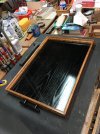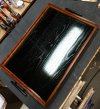I’m paused in this project because of cataract surgery. I am gluing the miters of a serving tray with the ebonized oak base resting in dadoes in the cherry sides. I was able to glue one long side to the two short sides using PVA glue. Then I slipped the base into the dadoes and I’m left gluing the remaining long side to the two short sides. Though the test assembly seen in the photograph looks good, I found that closing the remaining miters took a lot of clamping using bar clamps with paper shims to remove the gaps. I am way too slow to use PVA glue, even Tite Bond Extend, before the glue sets. If I use epoxy, squeeze-out would likely slop over the edges and the base as well. I tried CA glue on one of the miters, letting it seep into the miter after I had clamped it. When I released the clamp, it popped. I am left with only the alternative of small pin nails, 23 gauge, into the remaining miters after I have clamped them, then using capillary action to get some CA glue in as well. A prior test with 1/2 inch pin nails showed amazing holding power. I will not be able to try this until I get my new eyeglasses but I’d like any other suggestions before I try this final option. Thank you.
You are using an out of date browser. It may not display this or other websites correctly.
You should upgrade or use an alternative browser.
You should upgrade or use an alternative browser.
Serving tray
- Thread starter Bruce Mack
- Start date
Wow, that oak looks incredible. Which way did you choose to ebonize?
Thank you! I used a couple of applications of India ink followed by Tru-Oil. The Tru-Oil is a proprietary mix of linseed and other oils which. I have read, is heated in an airless environment to permit quick polymerization and drying after it is applied. It is dry to the touch in well less than an hour. Although it is marketed for gunstocks it is also used by makers of string instruments. I am neither, just a rank amateur, but it allowed me to rise well above my station. I had not used India ink for anything before and was surprised at how well it covered the oak and entered the pores.Wow, that oak looks incredible. Which way did you choose to ebonize?
I will try this. Thanks.I think that if you trim the tray just a tiny bit, a hair, on the long side it will fit. Yes, I have done this and it did work.
To Joe and Berta. I incorporated both suggestions as well as trimming one miter which was off angle with a chisel. It closed well and on inspection, it still looks good. I had difficulty related to tremor and had to break the miters, scrape off the glue, and reapply it. I know PVA glue does not adhere well to dried glue and I have to decide whether to secure the miters with 23 g. pin nails too. The tray is a gift and I don't want a miter to open later.
Nice work! Looks great!
Thank you!
Getting back to your original ?: for your next project involving gluing and truing a box type frame, consider using a strap clamp. Set the 4 corner pieces close to the size of the box when you are doing the dry run test fit. Apply glue to all 4 corners, set the pieces in place, slip the strap over the piece, and tighten the clamp. Contrary to popular belief, well crafted joinery of any type doesn't need 100s of pounds of pressure to make a solid joint. A good press fit held in place will create a rigid and lasting joint with modern glues. Real high pressures via bar clamps and heavy duty F clamps are only needed if you are bending and forcing the wood pieces to fit.
LATEST FOR SALE LISTINGS
-
For Sale Electrical supplies (Are you building a new shop?)
- Started by DSWalker
- Replies: 0
-
-
-
-
For Sale Powermatic PM 701 Mortiser, 4 Powermatic Chisels (3 unused in wrapper) $550
- Started by frankc4113
- Replies: 0


